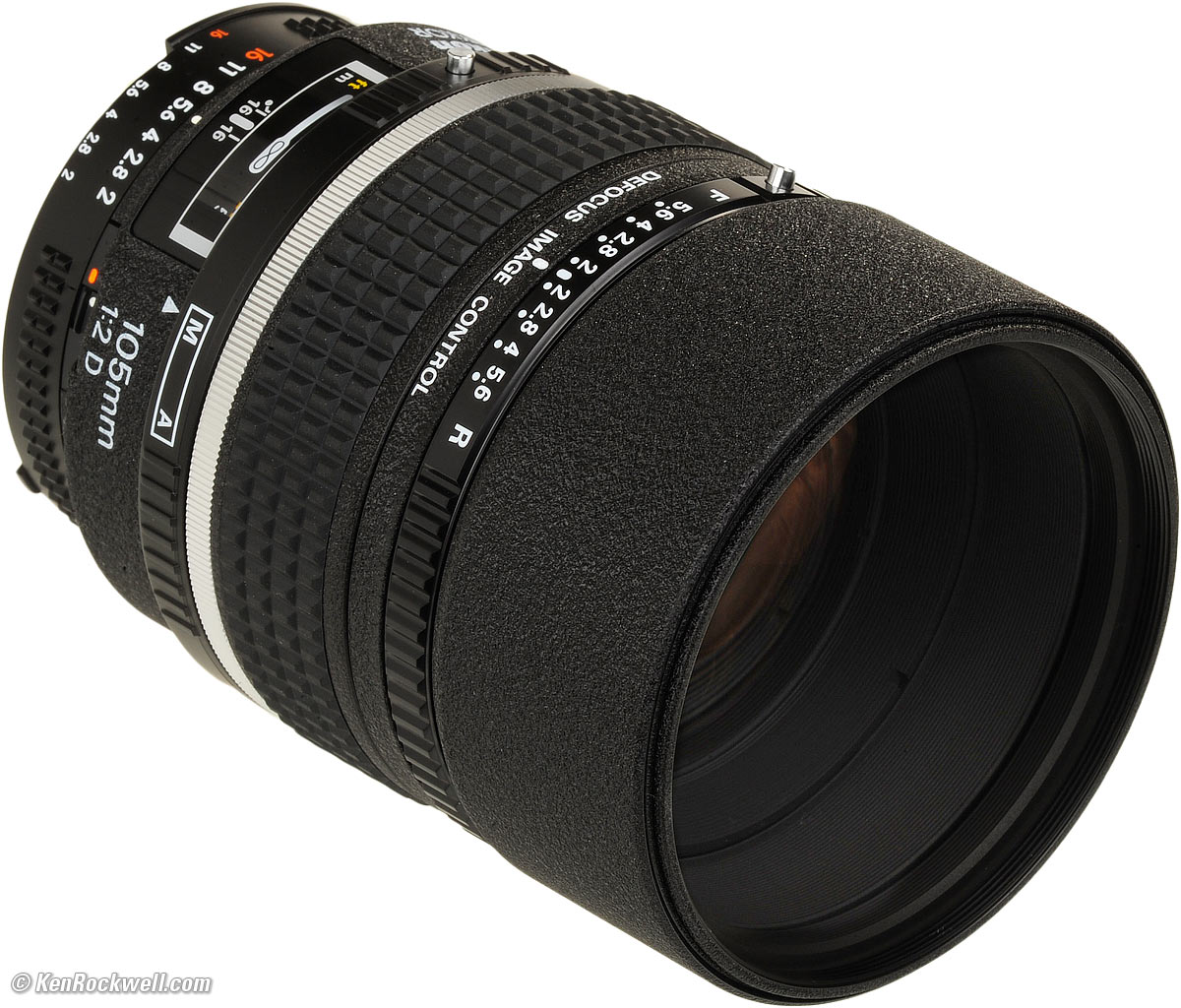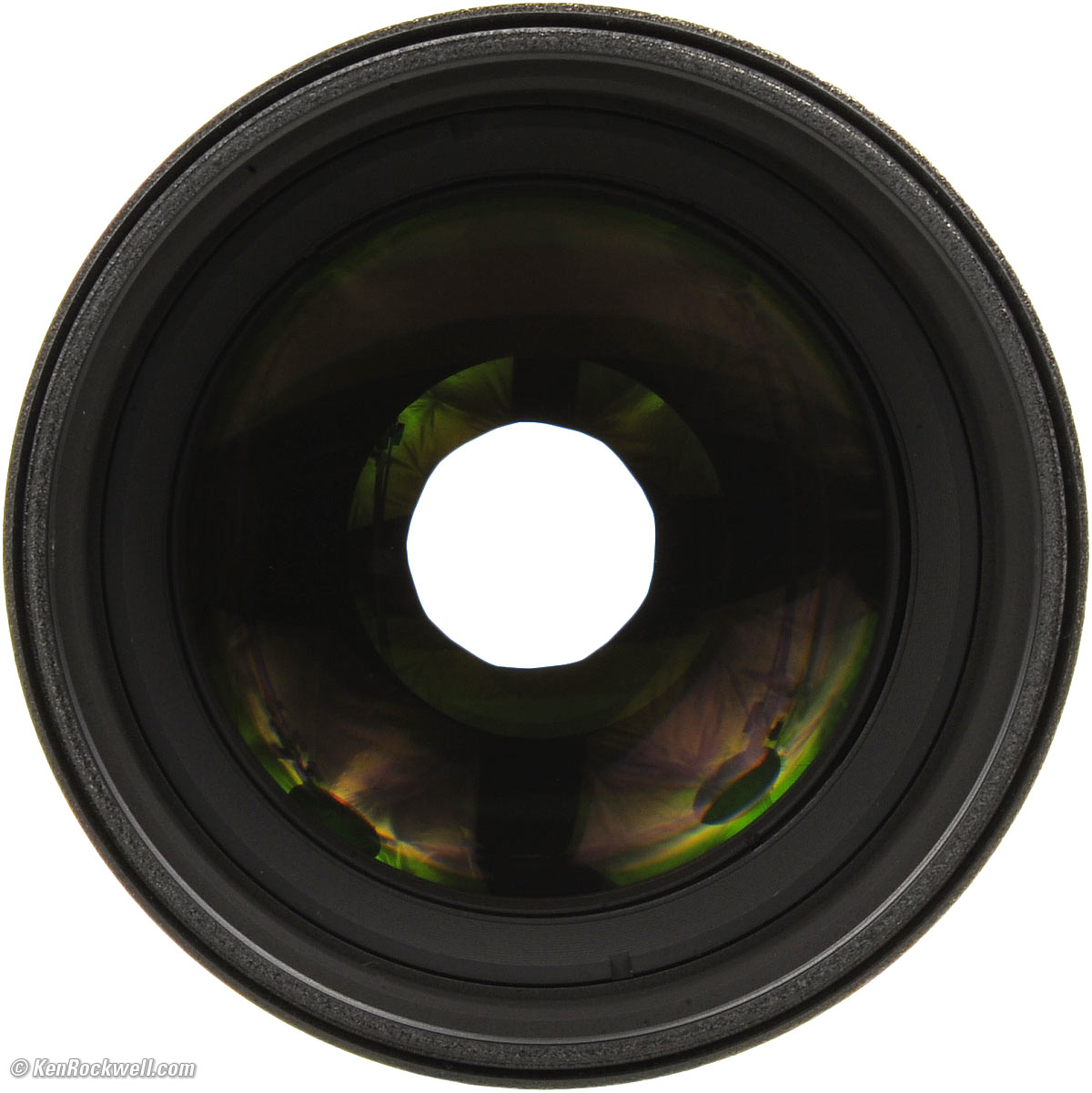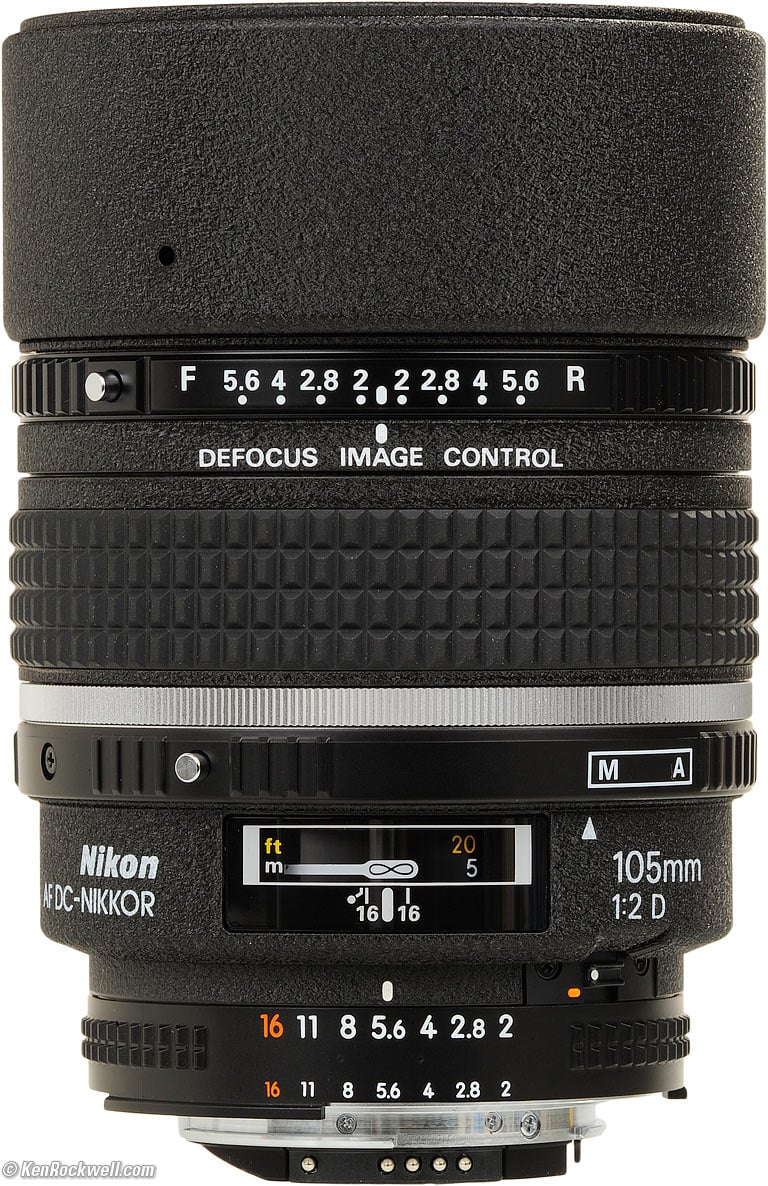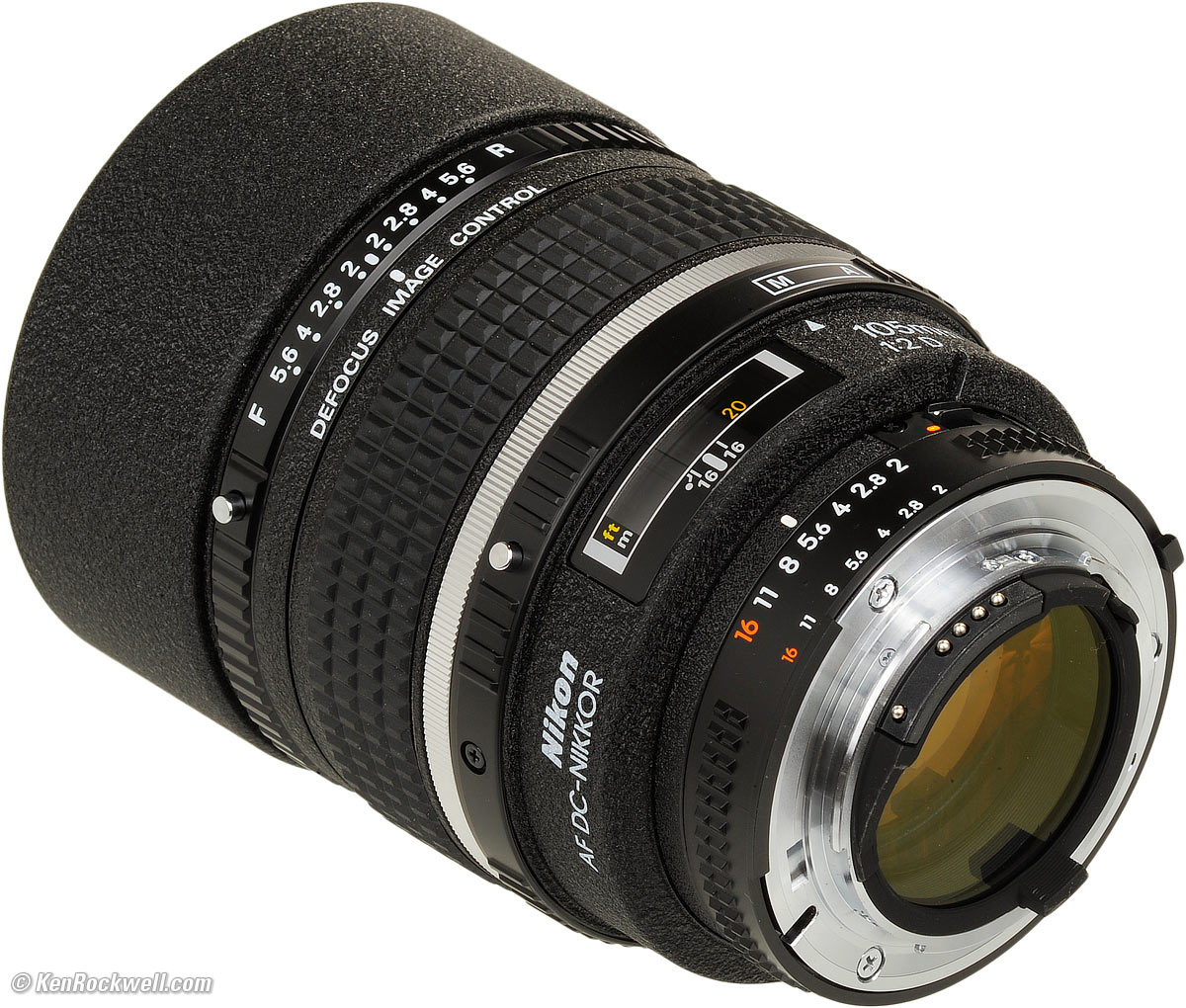Nikon 105mm f/2 DC
The Prince of Bokeh (1993-2021)
Intro Specs Performance Recommendations
Nikon AF DC-NIKKOR 105mm f/2 D (72mm filters, 22.0 oz./624g, 3'/0.9m close focus, about $500 used if you know How to Win at eBay). enlarge. I'd get it used at eBay, at Amazon or at B&H.
This all-content, junk-free website's biggest source of support is when you use those or any of these links to approved sources when you get anything, regardless of the country in which you live. Thanks for helping me help you! Ken.
July 2022 Nikon Reviews Nikon Lenses All Reviews
See also the very similar Nikon 135mm f/2 DC.
| Optics: | |
| Mechanics: | |
| Ergonomics: | |
| Usefulness: | |
| Availability: | |
| Overall: |
Ideal Uses: Nikon's best-built and one of their sharpest 105mm lenses, and better bokeh than any other Nikon 105.
Not for: Cheapskates. As a pro lens, it's priced right for a lens which could last you the rest of your life. This is Nikon's best 105mm lens unless you specifically need macro ability. This DC lens is at least as sharp as the 105mm macro, with superior build quality, bokeh and speed.
Introduction top
Intro Specs Performance Recommendations
Defocus Image Control Focus Compatibility
|
|
The Nikon AF 105mm f/2 DC is one of Nikon's very best lenses. Nikon has always made extraordinary 105mm lens, ever since its first 105mm lenses from rangefinder days, and this is the best yet.
It works on almost all 35mm and DSLR Nikons, however it won't autofocus on the FTZ adapter on Z mirrorless cameras. It will have full data communication and auto exposure used on the FTZ, if you don't mind manual focus.
The Nikon 105 DC is among the sharpest lenses ever made, and it's built pro-tough out of metal in Japan, not out of plastic in China.
The Nikon 105 DC has an almost identical bigger brother, the 135mm f/2 DC.
This 105mm f/2 DC is as sharp, and often sharper than Nikon's 105mm f/2.8 AF-D MICRO-NIKKOR, and this DC lens has the advantage of adjustable and superior bokeh.
The built-in metal hood is superb: it locks in position by screwing-down. Even without the hood extended, the glass is well recessed into the barrel.
You have to move a ring to get to manual focus mode, and once you do, manual focus is fantastic.
I'd get my 105mm f/2 DC used at eBay (How to Win at eBay), at Amazon or at B&H.
Nikon 105mm DC. bigger.
Defocus Control = Superior Backgrounds
DC stands for Defocus Image Control. A lot got lost in the translation on the way from Japan. The key word is control, not defocus.
This is not a soft-focus lens; it is a lens that has been specifically designed and patented both for superior bokeh (the softness of out-of-focus areas) and the ability to control this bokeh for optimum results under all conditions.
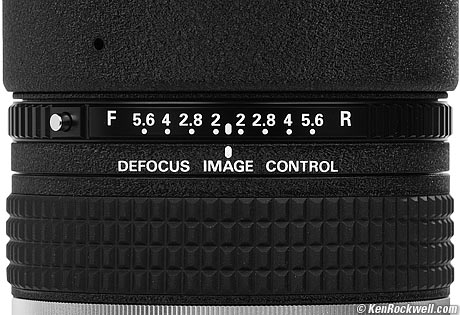
Defocus Image Control.
How do you set this 105mm lens for optimum bokeh? Easy: set this ring to the same aperture at which you're shooting. Press the unlock button on the left in order to move it, otherwise it stays locked. Set it to the R side to make backgrounds (REAR) go soft and disappear, or the F side if you want to optimize it for junk in the foreground (FRONT).
Hint: You should almost never have out-of-focus objects in front of your subject or in the foreground. It looks unnatural and weird. Our eyes naturally focus on the closest thing to us, so it's uncomfortable when a photo has a soft foreground or other distractions on which our eyes can't focus.
The effects of this defocus control are very subtle. You won't see it through your viewfinder. When used properly, the 105 DC turns backgrounds into soft, smooth washes of color. Turn the ring the wrong way, and out-of-focus backgrounds get harsher. These are subtle effects. Computer people may not see these subtleties at all, but artists will.
Leave the Defocus Image Control ring at zero, and the 105 DC simply acts as the sharpest 105mm lens you've ever used.
The Defocus Image Control only affects the out-of-focus parts of the image. The in-focus parts are always super-sharp.
This is not a soft-focus lens. Only the unfocused parts of the image are made softer. No one in the USA understands this lost-in-translation subtlety, so many people mistake this for a soft focus lens. (If you set the Defocus Image Control beyond the aperture you're using, like set to f/5.6 when shooting at f/2, only then can you get a softer-focus effect.)
This lens is so unique that Nikon will probably discontinue it just around the time people start figuring out what it does, and then the used price will skyrocket to $4,000, just like it did with the 28mm f/1.4, for exactly the same reason.
Focus top
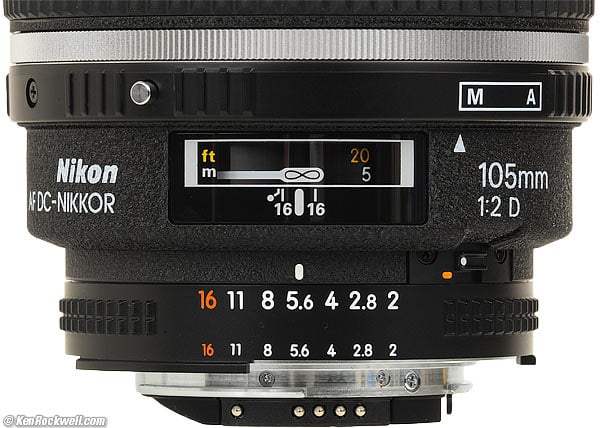
Nikon 105mm DC Focus Controls.
When you set the Defocus Image Control away from zero, the focus shifts. Be sure to focus after you set the Defocus Image Control (DIC). That's why the ∞ mark has a white band melting off to the left: with the DIC set to optimize defocus behind the subject (REAR), infinity comes up along that bar. With the DIC set towards F (FRONT), infinity comes up at closer on-scale distances. Don't sweat this; this is how the optics recombobulate themselves for optimum performance. If you're an engineer and aren't getting this, leave the DIC at zero.
To switch between auto and manual focus, press the unlocking button on the left, and rotate the AF Mode selector between M or A.
For use on most Nikons made since the 1980s where aperture is set or controlled on the camera, be sure to set the aperture ring to 16, otherwise you'll see a blinking " fEE" message. There's a sliding lock to keep it set at 16, just above the 2 in the photo above.
I'd get my 105mm f/2 DC used at eBay (How to Win at eBay), at Amazon or at B&H.
It works on almost all 35mm and DSLR Nikons, however it won't autofocus on the FTZ adapter on Z mirrorless cameras. It will have full data communication and auto exposure used on the FTZ, if you don't mind manual focus.
This 105 DC lens works incredibly well on FX, 35mm and DX Nikons like the D700, D3X, D7000 and F6. It works fantastically on manual-focus cameras like the F2AS, F3, FE and FA, since it has a real manual-focus ring that works exactly as it should.
The 105mm f/2 DC AF works perfectly with almost every film and digital Nikon camera made since 1977. If you have a coupling prong added to the diaphragm ring, it's perfect with every Nikon back to the original Nikon F of 1959.
The only incompatibility is that it will not autofocus with the cheapest D40, D40x, D60, D3000, D5000 or D5100, but if you focus manually, everything else works great. These cameras have in-finder focus confirmation dots to help you.
See Nikon Lens Compatibility for details on your camera. Read down the "AF, AF-D (screw)" column for this lens.
Nikon says do not use the old PK-1, PK-11, K1, BR-4, BR-2 or K2 extension rings because they will damage the CPU contacts. Instead, use the modern PK-11A, BR-6 or BR-2A rings. Also the 105DC won't work with the DX-1 AF finder for the rare F3AF.
Production and History intro top
I'd get my 105mm f/2 DC used at eBay (How to Win at eBay), at Amazon or at B&H.
1990: The first 135mm f/2 DC, on which this 105mm lens is based, was introduced.
1993: This smaller 105mm version was introduced as an AF-D lens. AF-D means that focus distance is coupled to 3D Matrix meters, especially helpful for flash exposures.
1995: The 135mm lens is finally updated to AF-D.
Nikon has made about 20,000 of these 105mm f/2 DC lenses, as of 2011.
Nikon has made 15,000 of the first non-D 135mm version from 1990-1995, and has made about 15,000 of the current 135mm AF-D version, also as of 2011.
2022: No longer available new.
Specifications top
Intro Specs Performance Recommendations
I'd get my 105mm f/2 DC used at eBay (How to Win at eBay), at Amazon or at B&H.
Name
Nikon calls this the Nikon AF DC-NIKKOR 105mm f/2 D.
Focal Length top
105mm.
Used on a DX camera it gives angles of view similar to what a 160mm lens would give on an FX or 35mm camera. See also Crop Factor.
Optics top
6 elements in 6 groups.
Multicoated, mostly in green with magenta.
There is an extra rear optical flat to protect against dust.
Rear Focusing.
Haruo SATO of Nikon received US Patent 5,841,590 on Nov. 24, 1998 for the defocus control design.
When an optical designer friend ran simulations and analyses on the design, he discovered another clever trick: Nikon designed the red end of the spectrum to focus in a slightly different plane to make skin look even better.
Diaphragm top
Nikon 105/2 DC at f/5.6. bigger.
9 curved blades.
Stops down to f/16.
Filter Thread top
72mm, metal.
Does not rotate.
Close Focus top
3 feet (0.9 m).
Maximum Reproduction Ratio top
1:7.7.
Focus Distance Scale top
Yes.
Depth-of Field Scale top
Not really; marked only at f/16.
Infra-Red Focus Index top
Yes, white dot on depth-of-field scale.
Size top
4.4" (111mm) extension from flange (4.7"/119mm overall) x 3.1" (79mm) diameter.
Weight top
22.000 oz. (623.55g), measured.
Nikon specifies 21.9 oz. (620g).
Teleconverters top
Nikon suggests using no teleconverters.
Case top
CL-38, not included.
Hood top
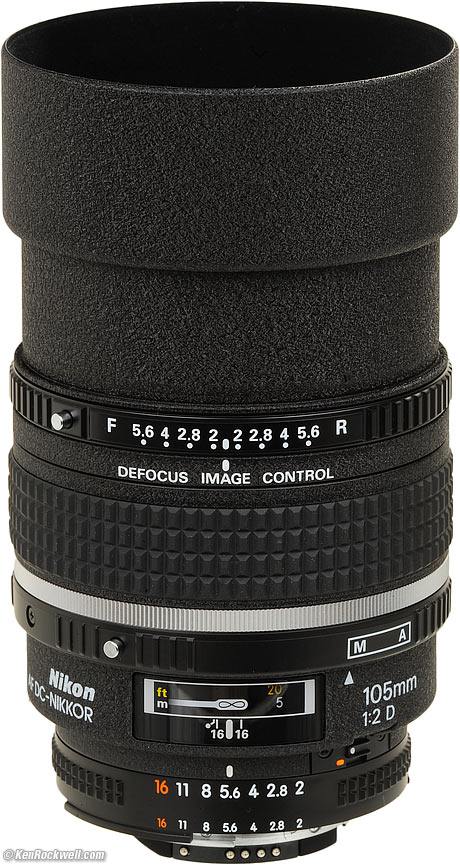
Nikon 105/2 DC with hood extended and locked.
Built-in telescoping, locking metal hood.
When you pull it out, rotate it two full turns to screw it into position. Unlike most lenses with telescoping hoods, this one won't keep pushing-back as you use it.
Nikon Product Number top
1932.
Box top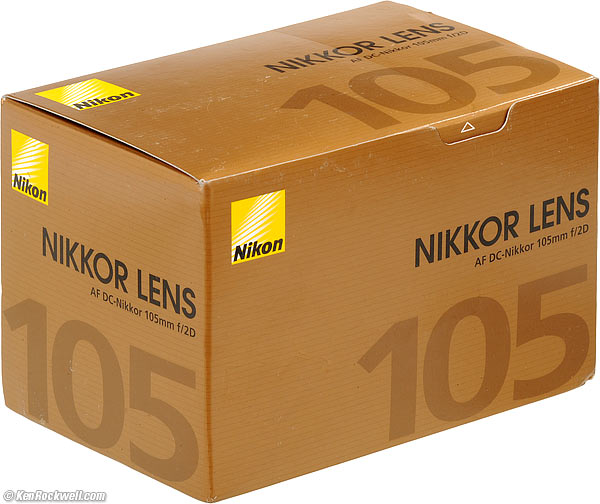
Nikon 105mm F/2 DC box, USA.
Single-wall cardboard.
Two white closed-cell foam halves, custom-fit and marked for the 105 DC.
Lens in clear plastic bag inside foam.
Paperwork sitting on top of foam.
Price, USA top
July 2022
About $500 used if you know How to Win at eBay.
April 2018
About $800 used if you know How to Win at eBay.
2011 August
$1,070 USA, $920 gray (see gray vs. USA).
About $800 used if you know How to Win at eBay.
Warranty top
Performance top
Intro Specs Performance Recommendations
I'd get my 105mm f/2 DC used at eBay (How to Win at eBay), at Amazon or at B&H.
Overall
This lens does it all. It's fast, super-sharp, and designed for the best portraits you've ever taken, as well as general use as a super-fast, super-tough and super-sharp short telephoto.
Bokeh top
Bokeh is extraordinary. It's the whole point of this lens.
Here are complete FX images at f/2:
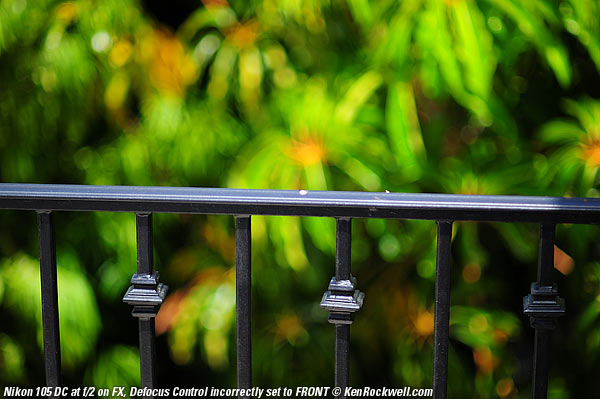
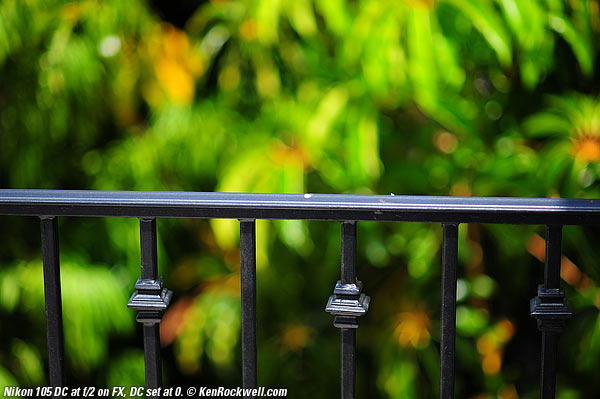
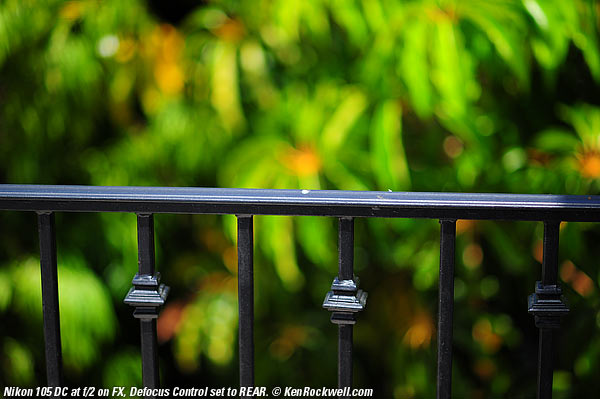
It's subtle, and if you look at the plants just a few feet behind the railing, you'll see how they are more distracting with the Defocus Control set the wrong way (for this example) to FRONT.
The out-of-focus plants get softer with the Defocus Control set to REAR.
Distortion top
The 105 DC has no distortion at 3 meters (10 feet), meaning less than a value of 0.1 as set in Photoshop's Lens Distortion Filter, on DX, FX and 35mm cameras.
Ergonomics top
Nikon 105/2 DC at f/5.6. bigger.
Except for having to unlock and rotate the M - A ring to switch between auto and manual focus, everything else about the Nikon 105mm f/2 Defocus Control is perfect.
Yes, you also have to move the Defocus Image Control manually, but I won't take points off because using is optional, and no other brand of lens on Earth offers this feature..
Falloff (dark corners) top
The Nikon 105mm Defocus Control lens has some falloff at f/2 on FX, and it's gone by f/2.8. I wouldn't even notice it at f/2 except by comparison to the same shot made at smaller apertures, and it's gone on DX, too, due to the crop factor.
I've gone out of my way to exaggerate this below.
Nikon AF DC 105mm f/2 falloff on FX and film at infinity.
© 2011 KenRockwell.com. All rights reserved.
|
Focus top
AF is fast. One full turn of the AF screw pulls it from infinity to 16 feet.
One light fingertip is all that's required to focus manually, and the manual focus ring is a huge, solid, rubberized ring.
Manual focus is the best of any AF lens. It's even better than most manual-focus Nikon lenses. This is because the 105 DC uses internal focus, so most of the lens stays put as it's focused. Since not much is moving inside the lens, the 105 DC requires very little effort to focus manually.
Autofocus accuracy is perfect on my D3 and D7000. Every f/2 shot is dead-on, set to zero or Rear.
Set to Front, the focus can sometimes be a tiny hair off at f/2, but not enough to worry about. I wish all lenses were this good, and seeing al the funny tricks played with spherical aberration, I'm very impressed that AF is accurate even as the Defocus Control is moved.
Use with Filters top
The metal 72mm filter thread doesn't rotate.
Use all the stacked thick filters you want; you're not going to get any vignetting.
Lateral Color Fringes top
None, on a D3 or D7000.
There is Spherochromatism, which is a different aberration
Mechanics and Construction top
Rear, Nikon 105 DC. bigger.
The 105mm f/2 DC is made as it should be.
It almost feels like a piece of American military equipment, except that it's not weather sealed.
It's not textured plastic like most of the toy-store trash coming out of the Orient today. Everything you see in crinkle-coat is solid metal.
Filter Threads
Metal.
Retractable Hood
Metal, internally flocked.
Screw-thread locking.
Barrel
Metal.
Focus Ring
Metal, rubber covered.
Aperture Ring
Plastic.
Finish
Black crinkle-coat.
Mount
Chromed brass.
Internals
Metal.
Markings
Paint.
Serial Number
Laser-engraved on bottom of aperture ring.
USA Models
Designated by US prefix in serial number.
Noises when Shaken
Assorted clunking from all the moving elements.
Sharpness top
Sharpness is extraordinary.
On a 12MP D700 or D3, or a 16 MP DX D7000, the Nikon 105/2 DC is super sharp edge-to-edge at f/2, and doesn't get any softer even in the farthest corners. It's just crazy; this lens just can't make a soft image if you're using it properly.
Have no fear, I shoot this puppy at f/2 and get super-sharp, and perfectly in-focus images, edge-to-edge at any distance. It's just plain scary.
On FX, it's sharper in the corners than the 105mm f/2.8 AF-D MICRO-NIKKOR, and on DX, the 105mm f/2.8 AF-D MICRO-NIKKOR is slightly sharper in the corners. They are all fantastic compared to the junky zooms from Sigma and Tamron people ask me to review.
Spherochromatism top
Like most fast long lenses, there is a little spherochromatism.
This means that out-of-focus highlights may have slight green tinges behind the subject, and slight magenta tinges when in front of the subject. This also helps the bokeh when you've got plants in the background.
If you're seeing color fringes, it's because you're not in focus.
Recommendations top
Intro Specs Performance Recommendations
I'd get my 105mm f/2 DC used at eBay (How to Win at eBay), at Amazon or at B&H.
The Nikon 105 DC is the best 105mm lens I've ever used. It's at least as sharp as any of Nikon's 105mm MICRO-NIKKORs, and it stays that sharp at f/2 from edge-to-edge at any distance, its bokeh is lovely, and it's built like a tank.
The 105mm f/1.4 is nice, but made in China out of plastic. Its optics are great and it autofocuses on Z cameras, but yuck.
The 135mm f/2 DC is just as good, just 30% bigger, longer and more expensive. Everyone deserves to own either this 105 DC or the 135mm DC. The 135mm is better for head shots since you can stand a bit farther back, while I prefer 105mm for general shooting.
I'd get my 105mm f/2 DC used at eBay (How to Win at eBay), at Amazon or at B&H.
Nikon's 28mm f/1.4D came out at about the same time. It performed to the same extreme level, offered unique optics never seen before and was built to the same ultrahigh mechanical standard as the 105 DC. When Nikon discontinued the 28/1.4 in 2006, its used price quickly rose to over twice what the new price used to be.
More Information
© Ken Rockwell. All rights reserved. Tous droits réservés. Alle Rechte vorbehalten.
Help Me Help You
I support my growing family through this website, as crazy as it might seem.
The biggest help is when you use any of these links when you get anything. It costs you nothing, and is this site's, and thus my family's, biggest source of support. These places always have the best prices and service, which is why I've used them since before this website existed. I recommend them all personally.
If you find this page as helpful as a book you might have had to buy or a workshop you may have had to take, feel free to help me continue helping everyone.
If you've gotten your gear through one of my links or helped otherwise, you're family. It's great people like you who allow me to keep adding to this site full-time. Thanks!
If you haven't helped yet, please do, and consider helping me with a gift of $5.00.
As this page is copyrighted and formally registered, it is unlawful to make copies, especially in the form of printouts for personal use. If you wish to make a printout for personal use, you are granted one-time permission only if you PayPal me $5.00 per printout or part thereof. Thank you!
Thanks for reading!
Ken Rockwell.






